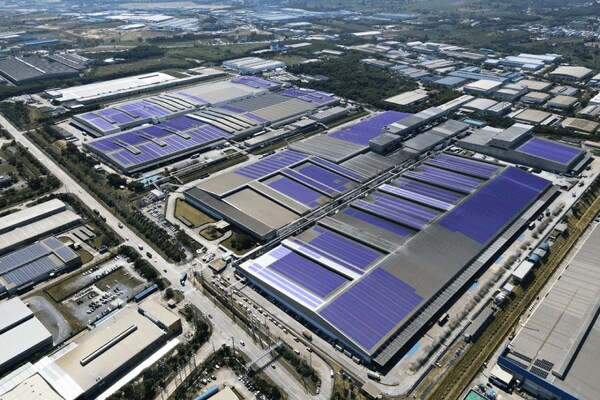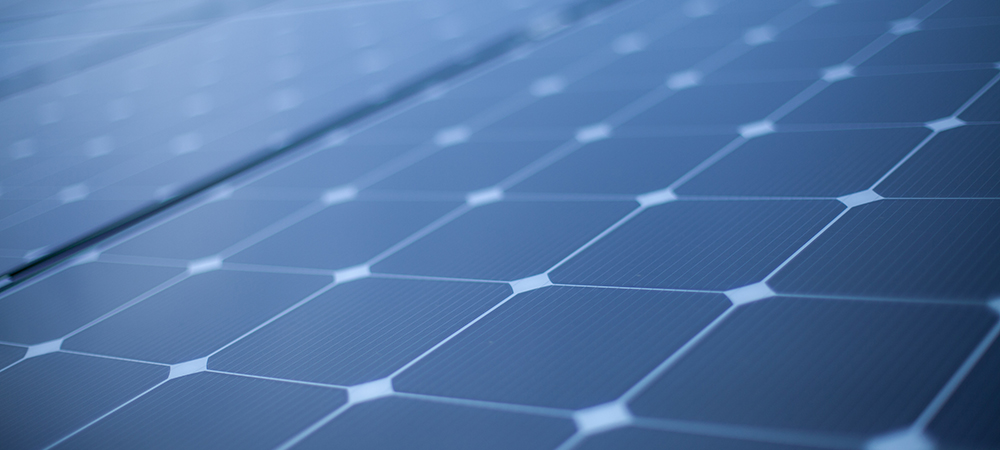On a rooftop, larger than 18 football fields in the heart of Thailand’s high-tech Eastern Economic Corridor, a record-breaking renewable energy project is under construction by international investors. Kansai Electric Power Co., Japan’s second largest electricity supplier, is creating the world’s biggest stand-alone rooftop solar panel installation atop a factory that manufactures high-performance Falken tires for the European market.
Together with a gas co-generation system and additional electric power fuelled by biomass from surplus rubber trees, the 40,000-panel, 100,000 square meter rooftop in 2025 will have a total output of 22MW, reduce Co2 emissions by 38,000 tonnes and ultimately enabling the factory’s owner, Sumitomo Rubber Industries Ltd, to function entirely on renewable energy.
For the companies involved and independent experts alike, the rooftop within the Amata City Rayong industrial park, 135 kilometres southwest of Bangkok, is further evidence that Thailand is now the clean energy frontrunner among the 10 countries that comprise the Association of Southeast Asian Nations (ASEAN) – a region with a $3.2 billion economy and 660 million consumers.
“In terms of the promotional force of the country, we think Thailand is the most advanced in the ASEAN region,” said Katsuhisa Yamamoto, Managing Director of Kansai’s Thai unit.
As part of a sweeping national sustainability strategy known as the Bio-Circular Green economy, the Thai government has successfully packaged a raft of subsidies, tax breaks and other incentives to lure investors to finance and build renewable energy-related projects. There has been much enthusiasm for this support from investors that in the first six months of 2023, 186 of 195 applications to the Thailand Board of Investment (BOI) for power generation projects were renewable energy related.
Companies seeking clean energy opportunities in Thailand span the investment spectrum from Japanese and Korean power utilities to Chinese and European electric vehicle makers and U.S. technology giants such as Amazon Web Services and Western Digital Corp.
In perhaps the most noticeable example of the clean energy revolution taking place in Thailand, the country that has long been one of the world’s leading manufacturers of cars and trucks powered by internal combustion engines has also become both the regional hub for electric vehicle production and its fastest-growing market.
This comes as a result of major investments by EV manufacturers such as BYD Co., Great Wall Motor and SAIC of China, Mercedes Benz of Germany and newcomer Foxconn Technology Group of Taiwan, better known as the world’s largest contract maker of electronics, including Apple iPhones.
Foreign investors are far from the only major players at the heart of Thailand’s war on global warming. The country’s largest enterprise, state-owned Fortune 500-ranked PTT PCL – still largely known outside Thailand as an old-economy oil and gas company – is spending billions of dollars on clean energy investments. They include a $1 billion EV joint venture with Foxconn and a $100 million partnership with the world’s largest car battery maker, China’s Contemporary Amperex Technology, or CATL.
Meanwhile, another state-owned power heavyweight, the Energy Generating Authority of Thailand, or EGAT, is transforming the country’s major reservoirs by topping them with floating solar farms to form some of the world’s largest dual-system power sources that deliver both solar and hydro-electric power.
The Thai private sector is also playing a major role, led by such companies as electric bus and boat maker Energy Absolute PCL and electricity producer B.Grimm Power PCL.
The contribution of Energy Absolute is claimed to be noticeable on the streets and waterways of central Bangkok, where public transport in recent years has become noticeably cleaner and quieter, the faint hum of electric buses and boats replacing the noise and fumes of diesel-powered predecessors.
Elsewhere, Thailand’s rapid industrial expansion has aligned with the growth of B.Grimm Power, a publicly listed subsidiary of the B. Grimm group, a Thai conglomerate established in Bangkok 145 years ago by German pharmacist Bernhard Grimm and an Austrian partner.
In the 1990s, the company expanded into energy when it saw an opportunity to provide gas-fired electricity and steam to factories in the modern industrial parks springing up along Thailand’s Eastern Seaboard. Today, B.Grimm Power is a multinational conglomerate that is not only one of the leading private power producers in Thailand but also supplies clean energy from solar, wind and hydro projects across Asia and as far as Europe, the continent from which its founders originally hailed.
B.Grimm Power is itself no stranger to record-breaking projects. In 2020, it teamed up with EGAT and Energy China to build the world’s first 45-MW Hydro-floating Solar Hybrid plant that today floats atop the 288-square kilometre Sirindhorn Reservoir in northeastern Thailand.
The same year, it also partnered with Korea Electric Power Corporation and Energy China to power Bangkok’s third international airport at U-Tapao and the adjoining Airport City – both flagship projects in the development of Thailand’s Eastern Economic Corridor, the hub of Thailand’s transformation into a knowledge economy. In another world first, B.Grimm Power and its partners have created a hybrid system for U-Tapao, comprising an 80MW gas-fired power plant, a 15MW solar photovoltaic farm and a 50MW energy storage system.
Meanwhile, in the industrial estates where its power business first thrived, B.Grimm Power is partnering with Amata Corp. PCL, a Thai company that is developing its industrial parks into so-called smart cities, and Siam Cement Group, or SCG, the country’s largest conglomerate, to increase supplies of clean energy and put more solar systems on factory roofs – a project also heavily backed by the Board of Investment.
Now B.Grimm Power is focused on what it terms a “greenleap” strategy in which it will invest some $2 billion to almost triple capacity from 3,668 MW to 10,000 MW by 2030 while at the same time doubling the proportion of renewable energy from 25% to 50% of the company’s total output.
There should be no shortage of takers for those renewables. With global CO2 emissions required to fall by 80% by 2050, B.Grimm Power estimates that Southeast Asia is going to need 920GW of renewable energy while only being on target to achieve 340GW – creating a shortfall of almost 600 GW.





